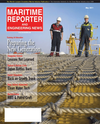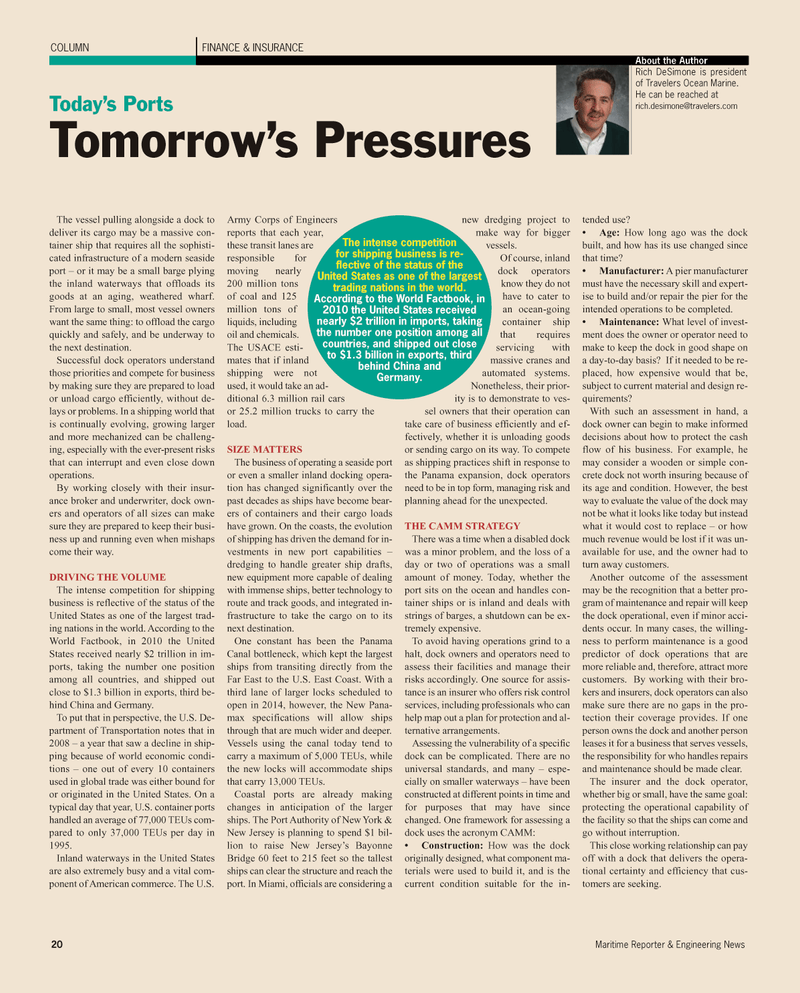
Page 20: of Maritime Reporter Magazine (May 2011)
Training & Education Edition
Read this page in Pdf, Flash or Html5 edition of May 2011 Maritime Reporter Magazine
20 Maritime Reporter & Engineering News
The vessel pulling alongside a dock to deliver its cargo may be a massive con- tainer ship that requires all the sophisti- cated infrastructure of a modern seaside port – or it may be a small barge plying the inland waterways that offloads its goods at an aging, weathered wharf.
From large to small, most vessel owners want the same thing: to offload the cargo quickly and safely, and be underway to the next destination.
Successful dock operators understand those priorities and compete for business by making sure they are prepared to load or unload cargo efficiently, without de- lays or problems. In a shipping world that is continually evolving, growing larger and more mechanized can be challeng- ing, especially with the ever-present risks that can interrupt and even close down operations.
By working closely with their insur- ance broker and underwriter, dock own- ers and operators of all sizes can make sure they are prepared to keep their busi- ness up and running even when mishaps come their way.
DRIVING THE VOLUME
The intense competition for shipping business is reflective of the status of the
United States as one of the largest trad- ing nations in the world. According to the
World Factbook, in 2010 the United
States received nearly $2 trillion in im- ports, taking the number one position among all countries, and shipped out close to $1.3 billion in exports, third be- hind China and Germany.
To put that in perspective, the U.S. De- partment of Transportation notes that in 2008 – a year that saw a decline in ship- ping because of world economic condi- tions – one out of every 10 containers used in global trade was either bound for or originated in the United States. On a typical day that year, U.S. container ports handled an average of 77,000 TEUs com- pared to only 37,000 TEUs per day in 1995.
Inland waterways in the United States are also extremely busy and a vital com- ponent of American commerce. The U.S.
Army Corps of Engineers reports that each year, these transit lanes are responsible for moving nearly 200 million tons of coal and 125 million tons of liquids, including oil and chemicals.
The USACE esti- mates that if inland shipping were not used, it would take an ad- ditional 6.3 million rail cars or 25.2 million trucks to carry the load.
SIZE MATTERS
The business of operating a seaside port or even a smaller inland docking opera- tion has changed significantly over the past decades as ships have become bear- ers of containers and their cargo loads have grown. On the coasts, the evolution of shipping has driven the demand for in- vestments in new port capabilities – dredging to handle greater ship drafts, new equipment more capable of dealing with immense ships, better technology to route and track goods, and integrated in- frastructure to take the cargo on to its next destination.
One constant has been the Panama
Canal bottleneck, which kept the largest ships from transiting directly from the
Far East to the U.S. East Coast. With a third lane of larger locks scheduled to open in 2014, however, the New Pana- max specifications will allow ships through that are much wider and deeper.
Vessels using the canal today tend to carry a maximum of 5,000 TEUs, while the new locks will accommodate ships that carry 13,000 TEUs.
Coastal ports are already making changes in anticipation of the larger ships. The Port Authority of New York &
New Jersey is planning to spend $1 bil- lion to raise New Jersey’s Bayonne
Bridge 60 feet to 215 feet so the tallest ships can clear the structure and reach the port. In Miami, officials are considering a new dredging project to make way for bigger vessels.
Of course, inland dock operators know they do not have to cater to an ocean-going container ship that requires servicing with massive cranes and automated systems.
Nonetheless, their prior- ity is to demonstrate to ves- sel owners that their operation can take care of business efficiently and ef- fectively, whether it is unloading goods or sending cargo on its way. To compete as shipping practices shift in response to the Panama expansion, dock operators need to be in top form, managing risk and planning ahead for the unexpected.
THE CAMM STRATEGY
There was a time when a disabled dock was a minor problem, and the loss of a day or two of operations was a small amount of money. Today, whether the port sits on the ocean and handles con- tainer ships or is inland and deals with strings of barges, a shutdown can be ex- tremely expensive.
To avoid having operations grind to a halt, dock owners and operators need to assess their facilities and manage their risks accordingly. One source for assis- tance is an insurer who offers risk control services, including professionals who can help map out a plan for protection and al- ternative arrangements.
Assessing the vulnerability of a specific dock can be complicated. There are no universal standards, and many – espe- cially on smaller waterways – have been constructed at different points in time and for purposes that may have since changed. One framework for assessing a dock uses the acronym CAMM: • Construction: How was the dock originally designed, what component ma- terials were used to build it, and is the current condition suitable for the in- tended use? • Age: How long ago was the dock built, and how has its use changed since that time? • Manufacturer: A pier manufacturer must have the necessary skill and expert- ise to build and/or repair the pier for the intended operations to be completed. • Maintenance: What level of invest- ment does the owner or operator need to make to keep the dock in good shape on a day-to-day basis? If it needed to be re- placed, how expensive would that be, subject to current material and design re- quirements?
With such an assessment in hand, a dock owner can begin to make informed decisions about how to protect the cash flow of his business. For example, he may consider a wooden or simple con- crete dock not worth insuring because of its age and condition. However, the best way to evaluate the value of the dock may not be what it looks like today but instead what it would cost to replace – or how much revenue would be lost if it was un- available for use, and the owner had to turn away customers.
Another outcome of the assessment may be the recognition that a better pro- gram of maintenance and repair will keep the dock operational, even if minor acci- dents occur. In many cases, the willing- ness to perform maintenance is a good predictor of dock operations that are more reliable and, therefore, attract more customers. By working with their bro- kers and insurers, dock operators can also make sure there are no gaps in the pro- tection their coverage provides. If one person owns the dock and another person leases it for a business that serves vessels, the responsibility for who handles repairs and maintenance should be made clear.
The insurer and the dock operator, whether big or small, have the same goal: protecting the operational capability of the facility so that the ships can come and go without interruption.
This close working relationship can pay off with a dock that delivers the opera- tional certainty and efficiency that cus- tomers are seeking.
COLUMN
Today’s Ports
Tomorrow’s Pressures
FINANCE & INSURANCE
About the Author
Rich DeSimone is president of Travelers Ocean Marine.
He can be reached at [email protected]
The intense competition for shipping business is re- flective of the status of the
United States as one of the largest trading nations in the world.
According to the World Factbook, in 2010 the United States received nearly $2 trillion in imports, taking the number one position among all countries, and shipped out close to $1.3 billion in exports, third behind China and
Germany.

 19
19

 21
21
